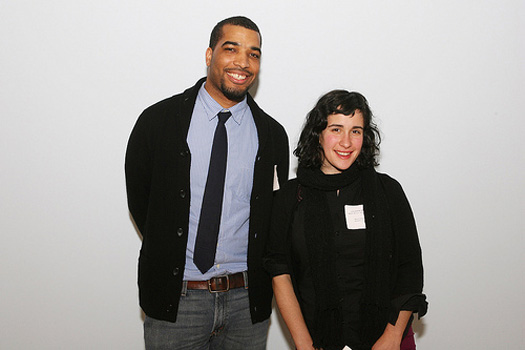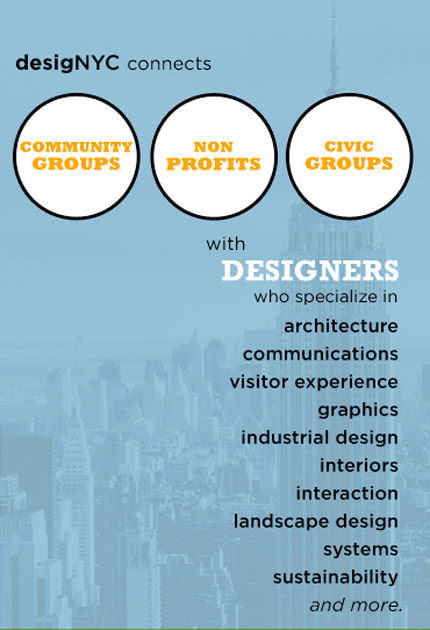
Esquire magazine art director Darhil Crooks and Bed-Stuy Farm Share founder Lauren Melodia team up at DesigNYC's launch event. Photo: Kate Glicksberg
Fired up by a reformist president and mayor, and with time on their hands in a drab economy, many New York designers are eager to work pro-bono. It’s a big city with a boatload of causes. Where does a socially minded professional begin? DesigNYC, a volunteer organization launched last week, sets the course by matching designers with nonprofits and offering guidelines for successful results.
Founded by Edwin Schlossberg, principal of ESI Design, DesigNYC grew out of conversations begun almost a year ago between ESI staffer Michelle Mullineaux and New York magazine’s design editor, Wendy Goodman. The project, Schlossberg explained at the launch event on January 28, lets people who “don’t have great communication skills” benefit from experts in sharpening messages. “Designers can help in framing arguments and problems just as nonprofits can help frame social issues,” he said. According to Goodman, the organization focuses “on one simple idea: Good design, effective design, makes people feel better.”
DesigNYC was inspired by such pro-bono initiatives as Taproot Foundation’s Service Grant program, which donates marketing, human-resources and IT capabilities to nonprofits; Public Architecture's 1% Program, for which architects are asked to donate 1 percent of their time to volunteer service; and Architecture for Humanity’s Open Architecture Network, which supports a free exchange of design ideas with progressive themes. “But we wanted to create something multidisciplinary and hyperlocal,” Mullineaux noted by phone, “and we knew we had to prototype it to create an effective collaborative program.”

Which is to say, DesignNYC, as matchmakers go, is no overbearing busybody; it’s a gentle facilitator of 12 pilot projects, from a brochure educating Brooklyn residents about healthy eating to a plan for lighting 125 blocks of Manhattan’s Broadway. (See complete list below.) Ideally, Mullineaux says, these activities will not only lead to an improved metropolis but also shape best practices for future iterations of the program, in both New York and other cities.
The founders’ first step was recruiting a powerful planning committee, including MoMA curator Paola Antonelli, Pentagram architect James Biber, internet pundit Clay Shirky and Design Observer contributor Steven Heller. The group issued requests for proposals from local nonprofit and civic organizations while reaching out to designers interested in volunteering. Word spread via blog and tweet, yielding more than 50 project ideas. (It helped that Shirky had some 27,000 Twitter followers at the time.)
The proposals were divided and reviewed according to discipline — architecture, web-based or graphic — and the 12 finalists were matched to design volunteers. Many of the founding committee members have joined the teams as advisors who will share wisdom gleaned from their own pro-bono pasts and serve as intermediaries with the DesignNYC core. (“They’re not project managers,” Mullineaux stressed, undoubtedly to their relief.)
So James Biber will look on as architect Andrew Berman helps turn a 1940s former fire boat house in East River Park into offices and an environmental education facility for the Lower East Side Ecology Center. (“To my mind it has the presence of a little boat, kind of slightly adrift from the city,” Berman says of the building, which sits partially on pylons descending into the river.) Steven Heller will oversee the Bronx River Alliance and graphic designer Felix Sockwell as they collaborate on posters and other strategies to promote the restoration of the Bronx River and development of an associated greenway. And Gabriela Mirensky, AIGA’s director of competitions and exhibitions, will work with the Bed-Stuy Farm Share, which distributes fresh produce in Brooklyn’s Bedford-Stuyvesant neighborhood, on a brochure about the importance of nutrition in combating diabetes and heart disease. The publication will be co-written with other grass-roots food projects in the area and designed by the Esquire art director Darhil Crooks.
“I promised Diana Balmori that I would not butt in, but I will certainly be there to offer my two cents and whatever experience,” assures architect Zack McKown, advisor on the Broadway Mall project, which seeks an environmentally sensitive way to light a strip of public space in Manhattan running from 60th to 185th Streets, and bring a friendly gleam to New York winter nights. Balmori, a distinguished landscape designer is but one member of the project’s pro-bono design troika, which also includes architect Joel Sanders and lighting designer Domingo Gonzalez.
To keep the projects on track with minimal intervention, DesigNYC drafted parallel guidelines for designers and clients. These advised all parties to spell out their expectations from the start, warned against flighty change orders and even suggested that designers submit an account upon the completion of their work indicating what the client would have spent in a paying world. Many project team members met for the first time at last week’s launch party. In the glow of this honeymoon period, none of the participants interviewed had taken steps to hammer out formal agreements. Compliments abounded.
“Lauren’s a very capable woman, a smart person,” said Crooks about his client, Bed-Stuy Farm Share’s founder, Lauren Melodia. “We’ve had a lot of discussions. We’re pretty much on the same page. No, there’s no contract yet. Once we get closer to actually producing this thing, there probably will be a contract.”
Melodia, in a separate phone interview, said, “I’m excited about having designers. We’re competing with multi-million-dollar fast-food ad campaigns, so we have to have people who know how to work within that framework to create effective outreach materials.”
DesigNYC also advises participants to keep written and visual records of their progress. Much will be learned by future teams from the sketches, prototypes and false starts of their predecessors. And the narratives that evolve will make compelling media stories, bringing prestige to the designers as a form of compensation.
Emphasizing the embryonic nature of this initiative, Mullineaux says, “We’re really just brokering introductions right now. Seeing if the teams can come to terms with an agreeable scope, schedule and set of deliverables is the work that needs to be done over the next couple of weeks. Not every single match will stick, not everyone will be in alignment.”
Change Observer will be tracking all 12 pilot projects. Stop back in six months for an update.
DesigNYC Pilot Projects
Client: Added Value
Designer: TODA
Project: Creating an integrated identity and communications outreach system for an organization that runs an urban farm in Red Hook, Brooklyn
desigNYC advisor: Michelle Mullineaux, ESI Design
Client: Bed-Stuy Farm Share
Designer: Darhil Crooks
Project: Designing a booklet, “Eating Healthy in Bed-Stuy,” that will provide information about local community food projects and about preventing diabetes and heart disease through nutrition
DesigNYC advisor: Gabriela Mirensky, AIGA
Client: The Broadway Mall Association
Designers: Joel Sanders Architect, Balmori Associates, Domingo Gonzalez Associates
Project: Designing an integrated winter lighting plan that will contribute beauty, public safety and commercial visibility to Broadway between 60th and 185th Streets.
DesigNYC advisor: Zack McKown, Tsao & McKown Architects
Client: Bronx River Alliance
Designer: Felix Sockwell
Project: Designing refreshed event iconography as well as templates for posters and other visual communications to better engage Bronxites in the restoration of the river and the development of the Bronx River Greenway.
DesigNYC Advisor: Steven Heller
Client: Enterprise Community Partners
Designer: Robin Key Landscape Architecture
Project: Developing a green roof and intergenerational garden for seniors and high school students at Servium Gardens senior housing development in the Bronx
DesigNYC Advisor: Margie Ruddick, Margie Ruddick Landscape
Client: Enterprise Community Partners
Designer: SOHBR Studio
Project: Designing community spaces at Anna Gonzalez Apartments, which provides homes for individuals with mental illness
DesigNYC Advisor: Sara Bengur, Sara Bengur Interiors
Client: Enterprise Community Partners
Designer: Andre Kikoski Architect
Project: Redesigning a children’s recreation room at Aegis, which provides homes for domestic violence survivors
DesigNYC Advisor: Sara Bengur, Sara Bengur Interiors
Client: Envirolution
Designer: M&E Engineers
Project: Creating new teaching models and tools for an innovative nonprofit that is instructs the next generation of students, green workers and small businesses about integrated building systems
DesigNYC Advisor: Maddy Burke-Vigeland, Gensler
Client: GreenHome NYC
Designer: Hot Studio
Project: Designing an identity and web platform that will engage New Yorkers in a large-scale interactive block party about green living
DesigNYC Advisor: Michelle Mullineaux, ESI Design
Client: New York City Housing Authority
Designer: The Rooster Design Group
Project: Designing a “Green Guide” that will engage and inspire residents to live a low-carbon lifestyle
DesigNYC Advisor: Lauren Yarmuth, YRG Sustinability Consultants
Client: Nostrand Park Crown Heights Development
Designer: WireMedia Communications
Project: Designing a new website and materials for an emerging community development group that provides services to the arts, business and cultural organizations of Crown Heights, Brooklyn
Client: Outstanding Renewal Enterprise / Lower East Side Ecology Center
Designer: Andrew Berman Architect
Project: Designing new interiors for an environmental learning center and offices in the renovated Fire Boat House in East River Park, Manhattan
DesigNYC Advisor: James Biber, Pentagram


Comments [2]
www.monkeedesign.com
02.06.10
02:26
02.08.10
05:27